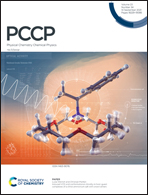First-principles prediction of strain-induced gas-sensing tuning in tin sulfide†
Abstract
A challenge in the application of two-dimensional (2D) SnS in gas-sensing field is that the SnS monolayer is highly sensitive to oxidizing gases, whereas it is naturally deactivated towards reducing gases. The non-sensitivity of SnS to reducing gases is a problem that needs to be solved urgently in an economic and effective manner. Hence, in this work, we propose a strategy of applying strain modulation on the SnS monolayer to optimize its sensitivity and selectivity for reducing gases fundamentally. Generally, the strain modulation applied on a semiconductor gives rise to a change in its band gap (BG). Based on the first-principles calculations, the strain on SnS was found to induce strong degeneracy and energy-level splitting. Unusually, the tensile strain (≥3%) applied could transform the SnS monolayer from indirect-gap semiconductors to direct-gap semiconductors, manifesting a promising optical application prospect but not appropriate for the gas-sensing filed. Comparatively, the compressive strain (≥3%) on SnS could generate new electronic states at the edge of the conduction band of the SnS monolayer, which increases the conductivity and the weak interaction. Thus, the adsorption of reducing gases on the SnS monolayer is enhanced from physisorption to chemisorption, resulting in a considerable increase in the sensitivity performance to the three reducing gas molecules (NH3, H2S, and CO). The induced symmetry breaking of the SnS monolayer under compressive strain leads to much higher surface activation towards reducing gases, which improves its adsorption capability and the ability of screening oxidizing gas molecules. The present work provides key information for novel designs of strain-sensitive dual-function sensors based on SnS.



 Please wait while we load your content...
Please wait while we load your content...